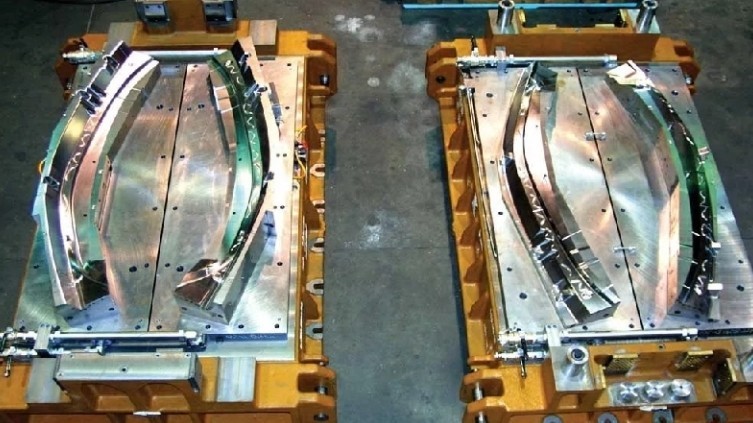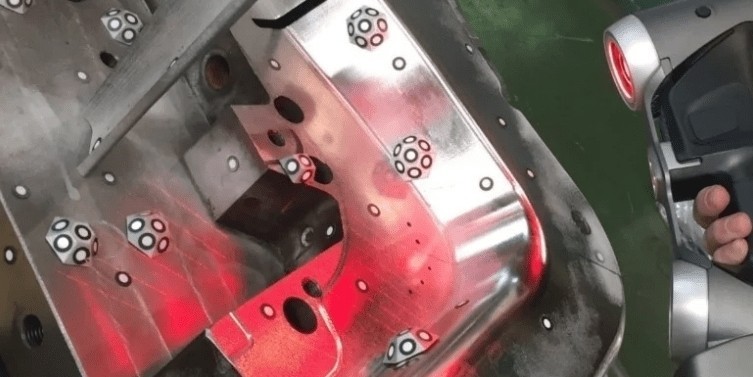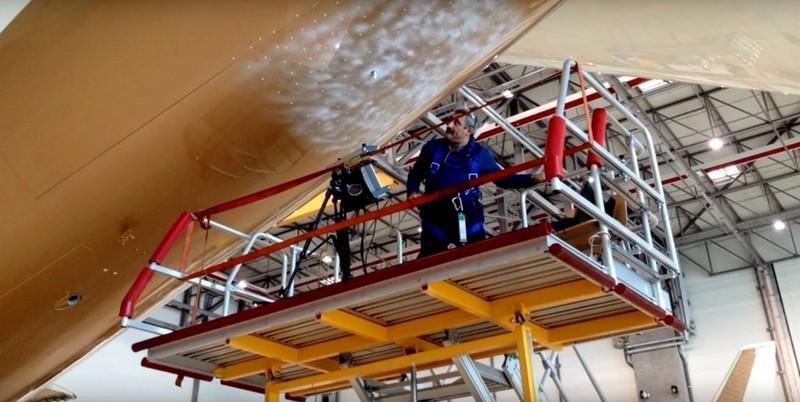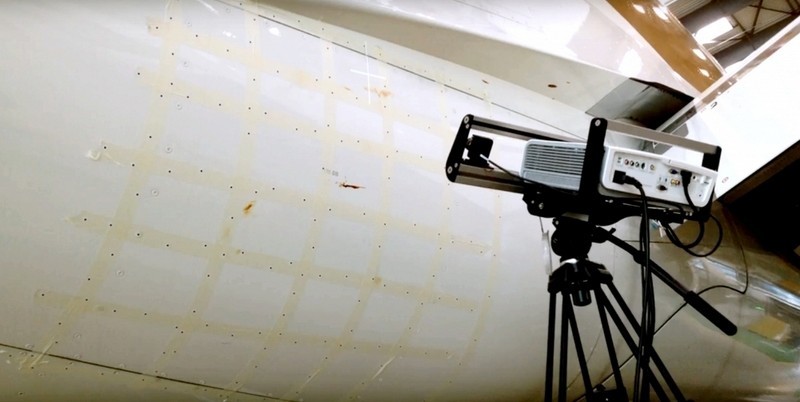
Hi everyone! This is Top 3D Shop, and in the following review, we will talk about reverse engineering, the considerations when choosing 3D equipment for it, and related case studies.
Read on to learn more.

Source: 3daeroscan.com
Reverse engineering, also known as back engineering, is the process of creating a project of parts or products with no drawings or documentation. By creating a digital CAD model using 3D scanning, these parts can be modified and optimized to extend their lifetime or add new functions. This method is used in many industries, including the production of military equipment or spacecraft.
With the growing popularity of 3D printing, reverse engineering is gaining ever-increasing attention. This is due to the fact that the reproduction of an object or design using digital modeling and 3D printing is more accessible to ordinary users than other production processes.
The ICON company uses a variety of 3D scanners to reverse engineer vintage car parts.

Source: 3dreveng.com
The process of reverse engineering involves three tasks: obtaining a sufficiently accurate digital impression of a part, converting the resulting image into a solid 3D model in specialized software, and subsequent digital processing of the model to eliminate artifacts, convert the format, and make some modifications so that the model design is suitable for the product launch.
Therefore, it is necessary to choose the right 3D scanner to obtain the primary data that best suits the existing task. For example, it is completely pointless to scan a piece of jewelry with a time-of-flight scanner for large objects, and vice versa: the very high accuracy of a desktop or handheld scanner is redundant when scanning, for instance, a sea vessel.
NeoMetrix Technologies uses the Creaform HandySCAN 700 3D scanner for reverse engineering and metrological control of various objects.

Source: 3dcaptura.cz
1. Prepare the object for scanning, apply markers if necessary. Note that glossy surfaces impede the work of 3D scanners, and reflective or transparent ones are nearly impossible to scan without a matte finish, so spray a temporary matte powder on the object to improve scanning accuracy.
2. Use a 3D scanner to capture important areas of the part. You may need to orient and rescan your object several times if it has holes or deep grooves.
3. Adjust and optimize the resulting polygonal mesh. Some scanners create very large files, making it difficult to post-process and print an object. Remove artifacts, check the surface stitch.
4. Import the mesh into CAD software equipped with reverse engineering tools.
5. Convert polygons to solids.
6. If necessary, add new objects to the resulting 3D model or delete unnecessary ones.
7. Use 3D printers or CNC machines to produce a new part according to the created model.
Reverse engineering of automotive parts with a Creaform 3D scanner using the VXmodel and Autodesk Inventor software

Source: 3d-scantech.com
An equipment manufacturer needed to optimize the production of impellers and eliminate manufacturing variances. It proved impossible to obtain accurate data of a part with holes, dead angles, and geometrically complex surfaces by traditional means. The impeller has narrow gaps between the vanes, which prevents measurement with a probe, so it was decided to employ 3D laser scanning and process the results using reverse engineering methods for comparison with the original digital model.

Source: 3d-scantech.com
3D scanning was performed by means of the ScanTech PRINCE high-precision 3D scanner with red and blue laser scanning modes. The device has a resolution of 0.020 mm and can quickly switch between modes. It is capable of scanning deep holes with a single red laser line and capturing the smallest details. In addition, the scanner is insensitive to ambient light.

Source: 3d-scantech.com
A full detailed model of the impeller housing with vanes was obtained using the 3D scanner.

Source: 3d-scantech.com
A complete digital model was created for analysis.

Source: shining3d.com
To participate in a sports and dance event called Colorguard, a captain had to do something for her team. She decided to create a cart for a heavy speaker that girls use to play music during training and performance. The speaker was to be easily removed from the cart if necessary. Besides, one of its handles needed restoration.
The speaker has three identical handles attached with screws. To replace the broken handle with a new one, the EinScan-SP was used to scan one of the remaining handles. Since the handle was very dark, it was dusted with a thin layer of baby powder so that the scanner could correctly recognize the surface. The EinScan-SP has the function of automatically stitching images when the object is rotated on the turntable and in different positions of the object. The program selects certain points from several scans and connects them. This allows users to scan not only the sides but also the top and bottom of the object.

Source: shining3d.com
To clean up the resulting image from artifacts and eliminate any damage on the handle, the Deform: Smooth tool in the free Autodesk Meshmixer utility was used. Using the Edit: Erase and Fill tools, the existing manufacturer's logo was removed, with the event logo added. Meshmixer was also used to make sure the screw holes were cylindrical. Processing the resulting STL file in Meshlab simplified the model and reduced the file size from 26 to 2.4 Mb.

Source: shining3d.com
The handle was printed using the Afinia H+1 3D printer with a TPU extruder and NinjaTek's Cheetah flexible filament. For greater rigidity, 80% filling was used. The resulting handle turned out both durable and pleasant to touch.

Source: shining3d.com
After examination, it was decided to use the speaker mount holes as attachment points to the cart. Measurements with a caliper would have taken plenty of time, it was more efficient to use the Shining 3D EinScan Pro 2X Plus portable 3D scanner. Markers were applied for better surface capture.

Source: shining3d.com
Although the EinScan Pro 2X Plus comes with the Solid Edge software (a complete CAD package with reverse engineering capabilities), it was decided to use Autodesk Fusion 360 because the user was more comfortable with it.

Source: shining3d.com
The resulting 3D model was too large to be printed in one piece, so it was split into two parts. It was printed with black PLA.

Source: shining3d.com
The print path was optimized to increase the strength of the cylinder and walls.

Source: shining3d.com
The cart handle was made of acetone-welded ABS plastic, and a piece of chipboard was used to make the base plate.

Source: metrology.news
Gestamp is an international company engaged in the design, development, and hot stamping manufacture of metal automotive parts for major carmakers. In modern production, there occurs a situation when changes are made to a CAD-designed die directly in production. Manufacturers often forget to reflect such changes in the documentation/original model. As a result, when a die is replaced on account of wear or damage, engineers have to make undocumented changes anew, which leads to errors and an increase in flaws.

Source: metrology.news
This situation can be fixed with the use of reverse engineering. After a die is set and configured, it is scanned and all the changes are recorded in the digital model. The resulting file, which fully corresponds to the scanned surface including the smallest details, is used for reverse engineering of the die. Changes identified using this method are incorporated into the original 3D model of the die.

Source: metrology.news
Gestamp specialists work with the Creaform HandySCAN 3D scanners, appreciating their accuracy, convenience, and compatibility with reverse engineering software.

Source: rangevision.com
RangeVision specialists investigated the possibility to speed up reverse engineering of objects with a large number of surfaces that change their curvature in accordance with mathematical laws. They used the sole of sports shoes as a test surface with such properties.

Source: rangevision.com
For this, they performed a 3D scan of the sole's geometry using the RangeVision Spectrum high-resolution 3D scanner (adjusted for object sizes from 30 cm to 1 m) and a rotary table. In 25 minutes, the device completed two groups of 8 scans, which were automatically linked into one model by the scanner software. Post-processing in the RangeVision ScanCenter program and obtaining a 3D model in .stl format took another 35 minutes.

Source: rangevision.com
Reverse engineering of the sole was carried out in Geomagic Studio using the NURBS method. First of all, artifacts and digital noise were removed, a coordinate system was created, unnecessary details were cut off, and the boundaries were smoothed.

Source: rangevision.com
After applying the NURBS method to the resulting surface, the final 3D model was created. Reverse engineering using NURBS took 4 hours. The entire task was completed within one working day.

Source: rangevision.com
The DE-Engineering company fulfills orders on high-precision 3D digitizing and reverse engineering of various objects, from aircraft to jewelry. The founder Dmitry Epstein maintains a video blog on YouTube, in which he publishes the most interesting works. DE-Engineering uses the RangeVision PRO and Gom Atos 3D scanners.

Source: rangevision.com
3D scanning of large objects, such as the frame of a helicopter or an airplane, has some peculiarities: to save time, markers are glued with strips of masking tape, and scanning is carried out from several points to facilitate stitching of the model.

Source: rangevision.com
For the armoring of two Citroen Jumpy vehicles, DE-Engineering specialists performed 3D scanning of the body and created an accurate model, according to which the metal plates were manufactured. The high precision of reverse engineering made it possible to install the armor without any additional fit. The whole process took seven days — two days for scanning and five days for processing.

Source: rangevision.com
DE-Engineering tries to use point cloud processing instead of polygons, which is more convenient from the point of view of model simplification. This allows maximizing the detail of an object in complex geometry areas and reducing it in simple ones. Processing is performed with the Catia software. Replaceable lenses are used to scan jewelry.

A client contacted Top 3D Shop with a request to restore a broken plastic part of a complex shape.

The part was created by 3D scanning with the RangeVision Pro, reverse engineering, and 3D printing.

Step 1. The length of the part is about 30 cm, so it was impractical to use medium-precision handheld scanners and solutions for large objects. Desktop scanners with a multi-axis table were not suited either, because the object did not fit in length into the half-open scanner camera. Thus, stationary optical or high-precision handheld scanners seemed to be the only options.
Step 2. The object has a geometry of medium complexity. For good scanning of such parts, a scanner accuracy of 40–60+ microns is required.

In the images: solid models of the object with the restored integrity
Step 3. The higher the accuracy of a 3D scanner and the more features it has, the more expensive it is. The customer's budget did not allow the use of GOM, Solutionix, or Scantech scanners, so Top 3D Shop employed the RangeVision Pro, which scans such small objects with an accuracy of 40 microns. Based on the data obtained from 3D scanning, reverse engineering was performed, and the part was prepared for printing.
First of all, it is necessary to define the size of the scanned objects — this affects the choice of scanning technology and the type of scanner (desktop, handheld, or floor-standing):
Dental scanners feature immensely high precision, high resolution, and rotary tables with the ability to attach an occluder and impression stands.
Versatile scanners are usually equipped with a multi-axis rotary table, or the scanner itself is fixed on axes with several degrees of freedom. This design allows for autonomous scanning of most of the object's surface. These scanners have a good scanning depth to correctly capture grooves.
For objects with a size of 10–50 cm, laser handheld scanners are better suited if at least one of the following conditions is met:
After defining the size of scanned objects, it is important to find out the required scanning accuracy and the measurement tolerance and see whether a metrological scanner is needed.
Reverse engineering of car parts at Jay Leno's Garage using the Faro Quantum ScanArm HD 3D laser scanner and the Stratasys Dimension 1200es 3D printer

Source: all3dp.com
To create point clouds and polygon models, it is usual to employ the proprietary software of a 3D scanner. Some 3D scanning and reverse engineering software products can also work directly with the most popular scanners.

Source: einscan.com
Geomagic Essentials is a program that extracts all the necessary elements of a scanned part for direct use in a CAD package. This software is designed to work with scans made by the Shining 3D EinScan Pro 2X (a joint product of 3D Systems and Shining 3D), which automatically processes and transfers the received data to the CAD environment. The application can be used both for metrological control and reverse engineering of parts and assemblies. The proprietary algorithms of mesh alignment and restoration, a wide range of options for fitting elements, the capability of creating cross sections, and high performance when working with large amounts of data can significantly reduce the work time of specialists.
Employing Geomagic Essentials to reverse engineer fan blades by user Gregory George

Source: 3dsystems.com
Geomagic Design X is versatile professional reverse engineering software that combines traditional CAD functionality with 3D scan data processing. Design X allows creating functional, editable solid models compatible with CAD software. The proprietary algorithms for accurate surface fit to 3D scans, mesh editing, and point cloud processing enable the design of components that perfectly integrate with existing parts. The easy-to-use mesh repair tools provide fast hole filling, smoothing, optimization, and comparison with the original model.
Reverse engineering of a compressor at Artec 3D using 3D scanning and the Geomagic Design X software

Source: all3dp.com
Autodesk Meshmixer is completely free software popular with 3D printing professionals. Meshmixer is designed for working with polygonal meshes rather than for parametric modeling and has a large set of tools for this. The functions of automatic analysis and correction are very convenient for processing 3D scans. The program is also capable of preparing a model for 3D printing, including supports. Meshmixer is simple and easy to use, with many tutorials available online.
The first video by AutoDesk to demonstrate the capabilities of Meshmixer

Source: blog.trimech.com
SolidWorks is a 3D design and reverse engineering program. Apart from traditional CAD/CAM functions, the software includes specialized tools for designing sheet metal parts, welds, and dies. A huge library of components and parts, improved realistic rendering, the capability of design check and structure analysis make SolidWorks one of the most powerful 3D engineering software products available.
The first video from the series of SolidWorks software tutorials: reverse engineering and 3D scan processing

Source: youtu.be
Solid Edge is an easy-to-learn toolset that covers all phases of product development: CAD design and rendering, modeling, reverse engineering, data management, and more. Siemens also provides training resources, access to the Solid Edge community, and ongoing software updates. If certain conditions are met, Solid Edge Premium can be used free of charge for one year.
Demonstration of the capabilities of Solid Edge 2021 from Siemens Software

Source: all3dp.com
The Autodesk Fusion 360 software and all of its modules are free for students, educators, hobbyists, and small businesses. The program is designed primarily for working with solid objects and is equipped with functional plug-ins.
Reverse engineering of a plastic housing at Dream3D using the HDI 3D scanner and the Autodesk Fusion 360 software

Source: scantech.com
The dark side of reverse engineering is intellectual property forgery and theft. The growing availability of the technology can give an advantage to unscrupulous manufacturers when legislation lags behind modern requirements. This means that prototypes that took developers a lot of time and money can be counterfeited with impunity using 3D scanning and printing technologies.
The ease of copying product designs forces large companies to experiment with ways to protect their intellectual rights — for example, by creating product defects that appear only in unauthorized production, or by embedding authentication barcodes directly into manufactured products.
Full 3D scanning and reverse engineering of a car body using the Creaform Go!SCAN SPARK 3D scanner.

Source: ductim-x.com
The future of reverse engineering lies in even greater process automation. Manufacturers are increasingly employing the power of artificial intelligence and cloud technologies in scanning and post-processing to enable inexperienced clients to carry out their work autonomously. This can be useful for specialists in a variety of fields, from doctors scanning body parts to workers on construction sites. 3D scanners keep on penetrating the consumer market and may eventually become as commonplace as cameras on smartphones (some of them are already equipped with a ToF sensor).
Update your browser to view this website correctly. Update my browser now
Write a comment